A US soldier crossed the border from South into North Korea and is believed to be in Pyongyang's custody.
Col Isaac Taylor, a spokesman for the US Armed Force in Korea, said a service member on an orientation tour of the Joint Security Area between the Koreas “wilfully and without authorisation crossed the Military Demarcation Line into the Democratic People’s Republic of Korea”.
The JSA is a border village in the demilitarised zone separating the two Koreas, where soldiers from both sides stand guard.
“We believe he is currently in DPRK custody and are working with our KPA counterparts to resolve this incident,” Col Taylor said, referring to North Korea's People's Army.
Admiral John Aquilino, who leads the US-Indo Pacific Command, confirmed that the service member in question was a private.
"He made a run across the demilitarised zone in the Joint Security Area and was picked up by the North Koreans," Admiral Aquilino said during the Aspen Security Forum.
White House press secretary Karine Jean-Pierre said the soldier's identity would be released after next of kin are notified.
The UN Command, which oversees the demilitarised zone, said earlier that a US citizen had crossed the border into North Korea “without authorisation”. It did not provide further details of the soldier's identity.
Media outlets reported the soldier had been due to face disciplinary action by the US military.
While he was being escorted back to the US and after going through airport security, the soldier returned and joined the border tour.
The US State Department bans Americans from travelling to North Korea “due to the continuing serious risk of arrest and long-term detention of US nationals”.
The State Department said it is unable to provide emergency services to US citizens in North Korea because it does not have diplomatic relations with Pyongyang.
Those who receive special validation to travel to the country are advised to draft a will and designate a power of attorney, discuss funeral wishes and care or custody of children and property, and prepare contingency plans, among other precautions.
The ban was enacted after Otto Warmbier, an American student, was detained by North Korean authorities while touring the country in 2015.
He fell into a coma after he was sentenced on charges of subversion. He remained in a coma when he was returned to the US in 2017 and died days later.
North Korea and South Korea technically remain at war after the 1950-1953 Korean War ended in an armistice.
It is a popular tourist destination and hundreds of visitors come to the area each day on the South Korean side.
Former US president Donald Trump met North Korean leader Kim Jong-un at the Panmunjom Truce Village in 2019 and even stood on North Korean soil by stepping across the demarcation line.
Defections between the two Koreas are rare but more common in the other direction, when North Koreans seeking to escape poverty and repression flee, typically across the northern land border into China.
The last time there was a defection at the JSA was in 2017, when a North Korean soldier drove a military Jeep then ran on foot across the demarcation line at Panmunjom.
He was shot by other soldiers as they sought to prevent his escape, but after hours of surgery he survived.
“Panmunjom is the most likely site this American chose to cross into North Korea because it's the only location one could attempt such a move out of the whole JSA tour,” Choi Gi-il, a professor of military studies at Sangji University in Wonju, told AFP.

It comes as relations between the two Koreas are at a low point, with diplomacy stalled and Mr Kim calling for increased arms development, including tactical nuclear weapons.
The US ambassador to the UN, Linda Thomas-Greenfield, said North Korea was a "threat to the world."
Seoul and Washington have increased defence co-operation, staging joint military exercises with advanced stealth jets and US strategic assets.
On Tuesday, the allies held the first Nuclear Consultative Group meeting in Seoul, which aims to improve nuclear co-ordination and boost military readiness.
“As we speak, an American nuclear submarine is making port in Busan today, the first visit of an American nuclear submarine in decades,” White House Indo-Pacific co-ordinator Kurt Campbell said after the meeting.
The last time Washington sent one of its nuclear-capable submarines to South Korea was in 1981.
Washington announced it would send a submarine capable of launching ballistic missiles with nuclear warheads to the Korean Peninsula in April, while South Korean President Yoon Suk Yeol was on a state visit. It did not specify when.
The move is likely to bring a strong response from the North, which baulks at having US nuclear assets around the Korean Peninsula.
Kim Yo-jong, the powerful sister of leader Mr Kim, on Monday said such actions would only “make the [Democratic People's Republic of Korea] go farther away” from potential talks.




